Contribute
| Technology - ECAT- Electrocardiogram Analysis Tool |
Sumugam Balachandran
02/18/2005
ECAT- Electrocardiogram Analysis Tool -
For Assessment of Risk for Multiple Life-Threatening Cardiac Ailments
The research article presents a pioneering Non-Invasive methodology
attempting to detect multiple cardiac ailments. A flexible software
analysis tool has been developed which given an input rhythm strip of
conventionally available high-resolution surface electrocardiogram
(ECG) performs the wavelet analysis to detect the presence of cardiac
abnormalities. ECAT has the ability to convert the acquired ECG data,
pre-process the ECG signal, wavelet transform the processed signal and
presents the results graphically in 3D. The design of the tool
addresses the important issue of providing a user interface for
clinical experts to choose the options to view the Wavelet Transformed
ECG. This article specifically deals with the results of the analysis
done to detect presence of Ventricular Arrhythmias and Tachycardia -
Wide spread cardiac ailments.
Ventricular Tachycardia (V-Tach)
– The signature signal for inducible patients is believed to have
potentials known as late potentials in the magnitude of 40mV
(typically) and of frequency of 40 – 200 Hz in the ST segment of the
cardiac waveform.
Electrocardiogram (ECG) data is acquired
using a high-resolution instrument, capable of resolving signal
amplitudes as low as 2-3 mV with a sampling rate of 1000 samples per
second. The acquired data is in BARD-Binary format. The data is
converted from the Bard-Binary format to a format suitable for the
preferred development package – MATLAB®. The converted data is run
through several Signal Preprocessing stages preparing the data for
wavelet analysis. The choice of wavelet transform analysis makes this
research effort novel in the realm to bio medical signal processing.
The wavelet transform analysis has the advantage of a joint time and
frequency domain representation compared to the traditional time or
frequency domain representation using Fourier analyses. This is best
suited for transient signals like the ECG/EEG signals where one is
interested in the time localization of the frequency components. In the
case of V-Tach detection, the need is to localize a 40mV anomaly in the
40-200Hz range at in time range of 200-300ms in a cardiac cycle that
lasts for 600ms. The results using ECAT to assess risk for the presence
of V-Tach are as shown:
For patients with the risk for V-Tach
the ECAT tool has localized the presence of high amplitude coefficients
in the time range of 250-300 ms and in the frequency range 40-200 Hz
(corresponding to 10-50 in wavelet scale coefficients). The software
has been used successfully to detect the presence of V-Tach as shown in
this article; the initial results have been hugely promising. However,
there large amount of data is required for more accurate testing.
You may also access this article through our web-site http://www.lokvani.com/

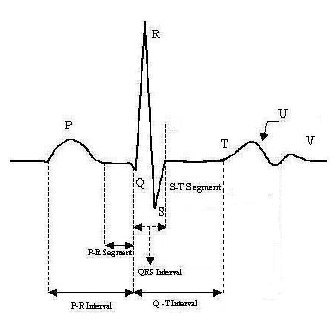
A Typical ECG showing the waves and intervals
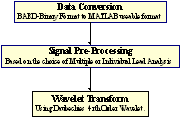
ECAT- System Level Block Diagram
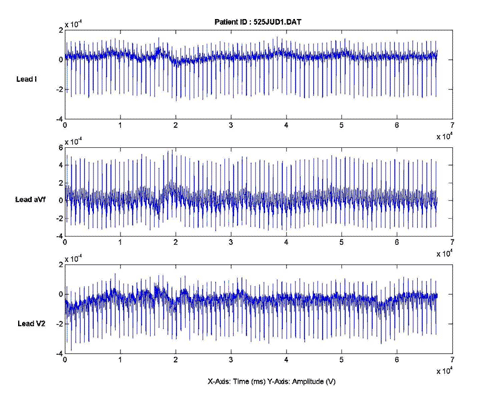
Raw Patient Data Converted from Bard Binary format in to MATLAB® useable format
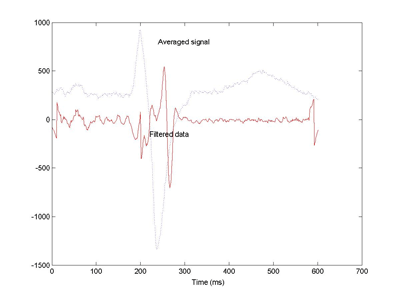
Filtered ECG data SIGNAL PREPROCESSING STAGE 1. Cycle by Cycle Registration by peak detection. 2. Averaging to improve signal to noise ration. 3. Vector Magnitude Summation. 4. Bi-Direction Parkes-McCellan High Pass Filtering
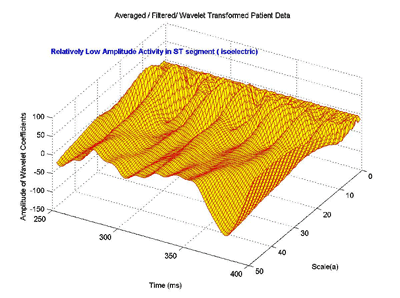
Wavelet Transformed Data – Late Potential Detection For Normal Individuals
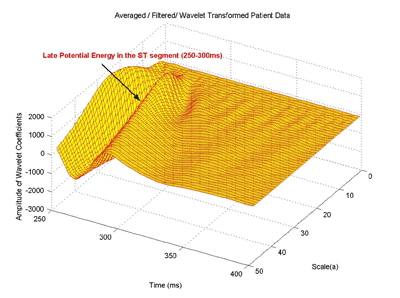
For Patients with risk for V-Tach